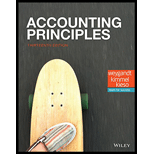
Concept explainers
(a)
(1)
The process of recording:
The process of accounting can be defined as a series of activities, which are initiated at the opening of a transaction and accomplished with the closing of books. The series of activities involves identification, recording, and communication. The first step in the recording process is analyzing each transaction in terms of its effects on the accounts. The accounts are identified for debit and credit. The second step in the recording process is to record the information related to the transaction in a journal. The last step in the process is to post the information recorded in the journal to the respective account in the ledger.
To determine: The primary source document for recording cash sales
(2)
The primary source document for recording credit sales
(b)
A journal entry refers to the logging of a transaction into accounting journal items. The journal entry consists of different recordings, each of which is a debit or credit. The first step in the accounting process is analyzing the transactions and recording them as journal entries.
Procedure for debiting and crediting an account:
- Increase in assets account, increase in expenses account, and decrease in liabilities account should be debited.
- Decrease in assets account, increase in revenue account, and increase in liabilities account should be credited.
All transactions affect the
To prepare: The journal entries for cash sales.
Want to see the full answer?
Check out a sample textbook solution
Chapter 5 Solutions
EBK ACCOUNTING PRINCIPLES
- Can you demonstrate the accurate method for solving this financial accounting question?arrow_forwardCan you explain this financial accounting question using accurate calculation methods?arrow_forwardJasmine Manufacturing Inc. assigns overhead to specific production jobs based on machine hours. At the beginning of the current year, estimated overhead costs were $840,000, and estimated machine hours were 60,000. By the end of the year, actual overhead costs were $875,000, and actual machine hours were 62,500.arrow_forward
- Alec Manufacturing produces a single product, with a selling price of $18 and a variable cost of $11. Fixed costs are $175,000 per period. What volume of sales in units is needed to earn a profit of $105,000 per period?arrow_forwardCan you solve this general accounting problem using appropriate accounting principles?arrow_forwardA company reported the following information for its most recent year of operation: purchases, $175,000; beginning inventory, $35,000; and cost of goods sold, $180,000. How much was the company's ending inventory?arrow_forward

 AccountingAccountingISBN:9781337272094Author:WARREN, Carl S., Reeve, James M., Duchac, Jonathan E.Publisher:Cengage Learning,
AccountingAccountingISBN:9781337272094Author:WARREN, Carl S., Reeve, James M., Duchac, Jonathan E.Publisher:Cengage Learning, Accounting Information SystemsAccountingISBN:9781337619202Author:Hall, James A.Publisher:Cengage Learning,
Accounting Information SystemsAccountingISBN:9781337619202Author:Hall, James A.Publisher:Cengage Learning, Horngren's Cost Accounting: A Managerial Emphasis...AccountingISBN:9780134475585Author:Srikant M. Datar, Madhav V. RajanPublisher:PEARSON
Horngren's Cost Accounting: A Managerial Emphasis...AccountingISBN:9780134475585Author:Srikant M. Datar, Madhav V. RajanPublisher:PEARSON Intermediate AccountingAccountingISBN:9781259722660Author:J. David Spiceland, Mark W. Nelson, Wayne M ThomasPublisher:McGraw-Hill Education
Intermediate AccountingAccountingISBN:9781259722660Author:J. David Spiceland, Mark W. Nelson, Wayne M ThomasPublisher:McGraw-Hill Education Financial and Managerial AccountingAccountingISBN:9781259726705Author:John J Wild, Ken W. Shaw, Barbara Chiappetta Fundamental Accounting PrinciplesPublisher:McGraw-Hill Education
Financial and Managerial AccountingAccountingISBN:9781259726705Author:John J Wild, Ken W. Shaw, Barbara Chiappetta Fundamental Accounting PrinciplesPublisher:McGraw-Hill Education





